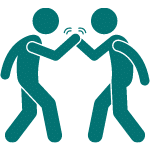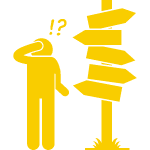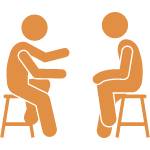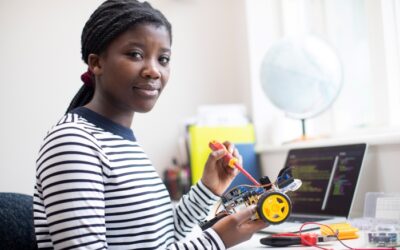We all say we want independent children, but man, is it frightening when your “independent” 4-year-old is quiet in the other room for too long. How about when you need to leave your 10-year-old home alone for the first time?
Then there’s that dreaded moment when your child suddenly has a driver’s license and can legally drive on their own, but the thought of it is just terrifying.
The ultimate test of independence, though, is when they go to college or otherwise move out of the family nest. Did you teach them enough? Will they make any huge mistakes? The answer to both of those questions is “probably.”
Accept Your Own Internal Conflict
I’ve never heard from a parent who doesn’t want their kids to gain confidence as they get older. But the idea of allowing our children to gain independence can cause an emotional tug-of-war.
We all say we want independent children, but sometimes our internal voice pushes us to act in a different way.
Whether it’s about our children’s safety or expectations that their decisions might not be the right ones, we feel the need to step in because all kids feel indestructible at a young age. Like that 4-year-old climbing up the bookshelf because who needs Mommy’s help when “I can do it myself!”
Further, during our children’s teen years, many times we don’t think there is enough blood flowing to their brain to get the reasoning part to balance out the emotional impact of newly created hormones raging through their bodies.
So, it’s no surprise we tend to want to keep control when what we really need to be doing is backing away.
Struggling Creates Capable, Independent Children
Instead of clearing the way so they never struggle to make a good decision, we can encourage independence by setting expectations and then coaching our kids when they need help solving their problems.
Independent children become self-motivated adults who do things because they see the value in what they want to achieve.
They also tend to make careful and considered decisions as adults because they were allowed to consider options, make mistakes, and fix them with the support and guidance from their parents as they grew.
A personal example:
I always thought of myself as a pretty good student, at least until Mr. Cessarini’s 5th grade class on world history. The subject was interesting, and Mr. Cessarini was a great teacher.
The problem was that I failed to turn in an important paper on time. My mother was called, and we made a joint visit to see Mr. Cessarini. Mom was great.
She listened patiently, asked questions, and then turned to me and said, “Okay, Rickie (that’s what she called me back then), this is your problem. I don’t ever want to get called in to see one of your teachers again for something like this. Fix it!”
Of all the oddly-named parenting styles, my mother and father were definitely not helicopter, snowplow, lawnmower, or bulldozer parents! Honestly, I’m not sure there is any label that describes my parents.
Probably the closest one is dolphin parents—authoritative in nature, firm but flexible in setting rules and expectations, and making sure we knew we owned our problems. But, we also knew they would help guide us if we asked.
I eventually finished and turned in my paper. Going through that experience of being called out for my poor choice was certainly embarrassing and uncomfortable to learn. But learning it early in life made a huge difference when it came to my level of confidence and sense of independence that has allowed me to steer my life in the direction I wanted.
My parents knew that for me to become independent, they needed to watch but let go. They knew that when the problem was mine to own and solve, I would figure it out. They also knew that I would stumble along the way, but I would figure it out.
Independent Children are Great Problem-Solvers
As parents, we get to see our children blossom as they grow and learn to deal with and solve problems.
While we never let them go, giving them space and responsibility, while always being ready to coach and mentor, really strengthens the bonds we want to have with our children throughout life. Because when we let them fly, they always find a way back home.
How do we do that? To solve problems, we teach our kids BUMR. During this process, we are also helping them to become more independent children.
Problem-solving with BUMR
BUMR stands for Believe, Understand, Make it happen, and Re-evaluate. It’s a process for approaching nearly any kind of problem.
- Believe you can solve the problem
- Understand the key issues that might be creating the problem
- Make it happen by trying a solution
- Re-evaluate what worked and what didn’t
Create the Right Environment for Independent Children
To create the right environment for the BUMR approach to work, we enable SEMH (sem-ah), which stands for Security, Encourage, Mistakes, and Help. It works no matter what age our kids are.

01 – Security
Make sure that your kids know they have a safe and secure environment. From toddlers to teens, they all want to know that wherever they may be, they can feel safe and secure and that you will make that happen.

02 – Encourage
When it comes to solving problems, we all can use a bit of encouragement. That doesn’t mean giving them the solutions (that’s what the U and M in BUMR are all about). Ask questions, and share some thoughts they might not have considered, but do not, DO NOT give them the solutions or answers.

03 – Mistakes
Struggling and making mistakes is one of the most important things to experience when it comes to gaining self-confidence. Thomas Edison made 1,000 unsuccessful attempts at inventing the light bulb. When asked, “How did it feel to fail 1,000 times?” Edison replied, “I didn’t fail 1,000 times. The light bulb was an invention of 1,000 steps.”

04 – Help
No, you don’t jump in and help them (unless they’re in danger, of course). Teach your kids to ask for help when you see them struggling and offer a simple “let me know if you’d like some help.” That creates a far more supportive environment than “here, let me do it for you.”
By adopting the SEMH approach, you will enable the confidence and independence that are so critical to the success of your children.
A personal example:
When my youngest daughter had just turned 14, I took a business trip to France. I invited her to join me. We decided she should bring along a friend. While we would have time together in the evenings, we knew I’d be busy during the day. Her having a friend to do things with would make the trip a wonderful experience in seeing another part of the world where English was not the primary language.
I was confident that two 14-year-old girls would be okay if they stayed together and didn’t stray too far from the hotel (this was the mid-1990s after all). There were plenty of restaurants and shops close by that we had walked past together, so I presumed there was plenty to do.
Well, that lasted about a day and a half. When I returned to the hotel that second day, my daughter pronounced, “Hey, Dad, we want to go to Versailles.”
Since they knew I wouldn’t be able to join them, they proposed that they go by themselves.
We had already ridden the train a number of times, so they knew how to buy tickets, and I was confident that the train would be safe enough. The challenge was getting to and from the train station, which was a 15-minute walk that was definitely not a direct route.
I told them that if they could show me that they could get back to the hotel from the train station by themselves, then they could go.
The next afternoon when I returned to the hotel was their big test … prove to me that they could get back to the hotel. They wanted to take the trip, so it was their burden to figure out how to make it work. I took them to the train station (in not the most direct route) and went back to work.
I’ll never know exactly how, but they were at the hotel when I returned later that evening. They did it without help from me, and in the process, proved to me and themselves they were capable map readers and problem solvers.
The next morning I left the hotel for business, not knowing if I’d see my daughter and her friend again without having to go find them. Much to my relief that evening, I found two elated and wildly giggling teenagers as they gushed about the details of their trip to Versailles.
Did they share everything about what they did, what they saw, and what happened? I’d like to think yes, but I’ve been a dad long enough to know they probably left out a few things. Perhaps they missed turns on the way to the train station or a few coming back. In the end, it didn’t matter because they got to explore on their own.
I could have arranged for a car and driver, but that would’ve been making their problem my problem. I saw their request to go as an opportunity to teach a lesson and encourage their independence.
Becoming Independent
There are two ways in which teens assert their independence: isolation and exploration.
Isolation is why kids tend to spend a huge amount of time on their own in their rooms. It’s not a bad thing. In fact, it follows the SEMH (security, encourage, mistakes, and help) framework.
Their room is a safe and secure place to be, they get to try things out on their own (in reasonable privacy) and make a few mistakes in the process, and when they do, they might ask for your thoughts.
When it comes to exploration, it’s much harder to create a safe environment where they are encouraged to be creative and make mistakes. And if you’re not with them, it’s impossible for them to ask you for help.
Having that knowledge, I used our experience in France to help my daughter and her friend feel the joy and excitement of exploration in as safe a way as I could.
I problem solved using BUMR. I believed I could help them go on their trip without having to miss work (which wasn’t an option) and without costing an arm and a leg (the private-car option). I understood the missing gap in their knowledge of how to get around (getting back and forth from the train station to our hotel).
I “made it happen,” as it were, by testing their ability to get home independently on a day when we had time and flexibility to work out any hiccups that may have come up. We re-evaluated the situation by discussing what worked and didn’t work in their strategy to get home.
After that, the ongoing SEMH approach to our relationship meant that they knew I trusted them and they had a safe plan of action. I encouraged them by going through the practice run of getting home independently. We talked about what to do if they ran into trouble, and then I “helped” them by letting them go.
Of course it was nerve-wracking, even with all the prep. But my daughter, now 34, still talks about that adventure. She lives overseas with her husband and two sons and has traveled around the globe to many more places than I have, and I’ve been to 39 countries!
I’d like to think that BUMR and my role as a parent using SEMH gave her the confidence and independence that has allowed her to become the woman, wife, and parent that she is today.
Their Solutions Build Their Confidence
Whether or not you have teens at home now, at some point, you will realize that your role has to change from constantly showing your kids what, how, and why to do things to simply letting them figure it out for themselves.
It’s a challenge for all parents, even me, but it’s absolutely necessary if they are ever to develop enough independence and confidence in themselves to become successful adults. Everything is not your problem to fix!
The more opportunities children have to solve little problems, the more equipped they will be to think creatively in solving larger issues.
By allowing our children to own and tackle their problems and make mistakes, we are giving them the gift of becoming independent children and helping them create the confidence they need to become capable adults.
By following BUMR and SEMH, we are showing our children exactly how to solve problems while letting them know we are there if they need us. It’s a win-win when they handle their own problems and the problems don’t become ours.
What To Do Next
1. Read more in the blog:
The Family Wisdom Blog shares valuable ideas across diverse topics.
2. Explore the Printables Library:
Our printables library is filled with must-have activity ideas, checklists, guides, and workbooks.
3. Subscribe to Our Newsletter:
Sign up for our newsletter for parenting tips to help you create the family team you've always wanted.
Rick Stephens
Rick Stephens is a co-founder of Raising Families. With 33 years of experience as a top-level executive at The Boeing Company and having raised four children of his own, he is able to support parents and grandparents by incorporating his knowledge of business, leadership, and complex systems into the family setting.
In his free time Rick enjoys road biking, scuba diving, visiting his grandkids, and generally trying to figure out which time zone he’s in this week. Read full bio >>





